The fourth and first book of the newly minted Cults of RuneQuest series is not only out, but also made it to the gloomy frozen wastes of Valind’s Glacier! Well, the south-western parts of it, I guess. I probably live more in Fronela than anything else, really… but even though it’s not frozen, it’s quite gloomy, hence the gloomy photos in this article!
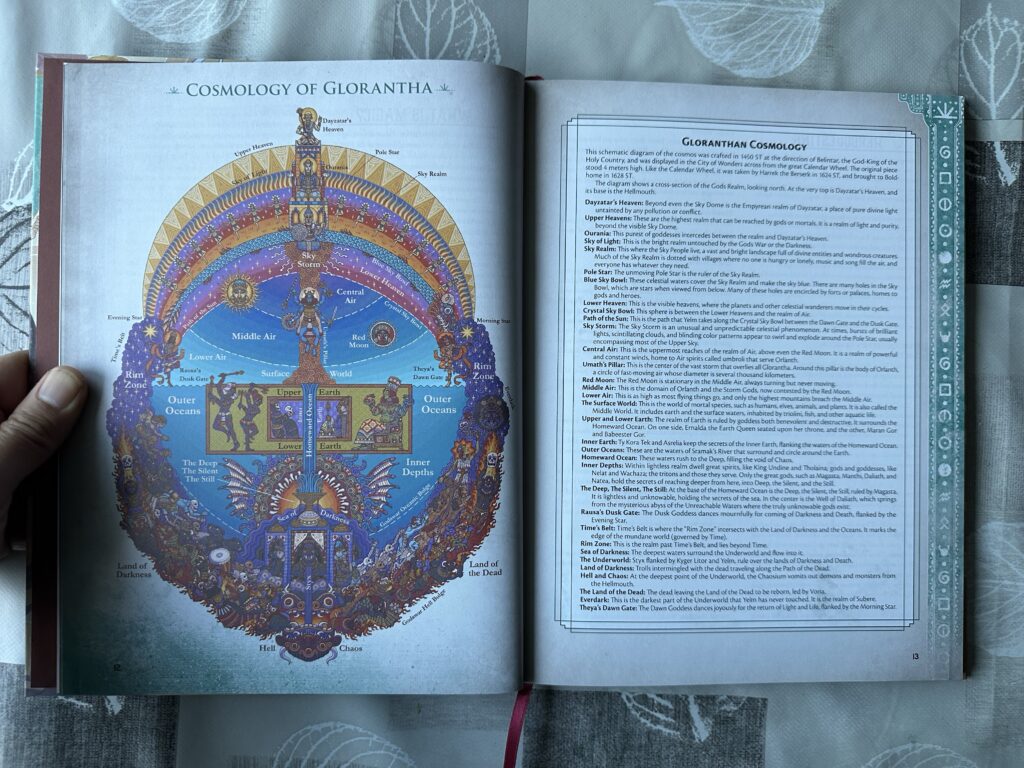
Anyway, Cults of RuneQuest: Mythology is indeed the fourth release of the ten originally planned books, after the Prosopaedia, the Lightbringers, and the Earth Goddesses, all of which I’ve reviewed here previously. But it’s also the first of all these books, as Jeff Richard explained himself in a recent episode of our podcast. It’s conceptually the introduction to the series, and it contains most of the material that was supposed to go at the start of the big Cults of Glorantha slipcase which was originally planned. Yes, Chaosium has a known problem of releasing their RuneQuest books in “the wrong order”, but I’ve already discussed this enough in previous reviews.
Before we dive in, you can get Cults of RuneQuest: Mythology in PDF from DriveThruRPG (affiliate link), or in hardcover and/or PDF from Chaosium. This article was done with a review copy that was sent to me by Chaosium. Thank you Brian and Dustin!
Overview
As usual, the first thing I do with a new RPG book is to smell it (yes, I’m serious), flip through it, and get a rough idea of the look and scope of it. I was immediately fascinated by this Mythology book, as I skimmed past many beautiful illustrations and maps, treatises on the nature of cults, short myths, and many more things you rarely see in any other game sourcebook.

A special shout-out goes of course to Agathe Pitie’s epic four-panel fold-out depicting Glorantha’s monomyth. You can get lost for a long time in there, trying to figure out who’s who and what they’re doing. I might have to check back on Joerg, I don’t know if he has eaten or showered or slept since he received his copy…
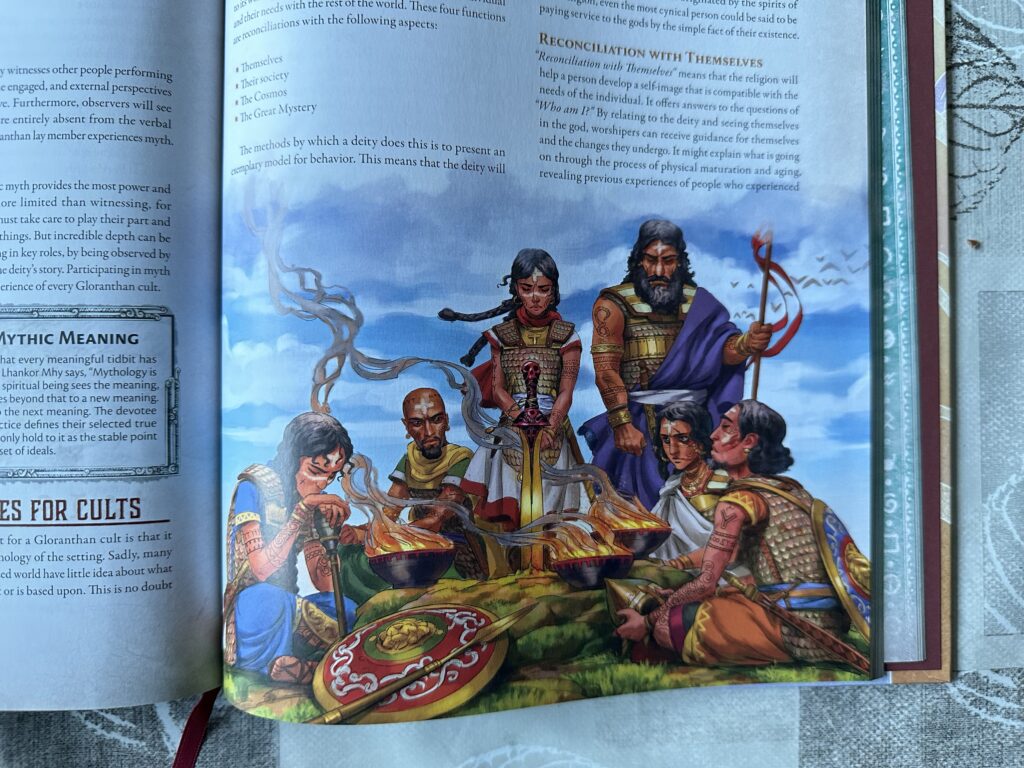
The rest of the book is on par with the other Cults of RuneQuest entries, which is to say it’s very pretty. There is Simon Cogswell’s beautiful and clean layout. There is Katrin Dirim’s eastern esoterica. Loic Muzy only has a painting or two in here (including the cover) but surprises us with some sort-of-Classical Greek-looking carvings. And there are many pieces of additional art, either original or lifted from previous publications. In fact, some of my favourite illustrations in Mythology are among these, such as the Humakti rites on pages 77 (see above) and 140.
How’s the editing, you ask. Well it’s OK but you’ll still find several instances of typos, unfinished sentences, unclosed parentheses, non-sensical text, outdated references, and more. Some of these issues are only in the PDF and will disappear when it’s updated to match the printed book, but it’s worth noting.
That Foreword
Once I started reading the book proper, confusion started. That confusion is of course completely intentional, but it still takes you by surprise.
The book starts with “This book is not for everyone”. It immediately blurs the line between you, the reader, and you, the RuneQuest character existing inside Glorantha, because of course roleplaying is the act that makes these worlds bleed into each other. It talks about Mythic Truth and then spreads biased misinformation about the Red Goddess and the Zzaburi, because of course these truths are manifold. And after turning the page, it reveals that it was all written by none other than trickster-shaman Greg Stafford himself, because of course who else would write this kind of stuff.
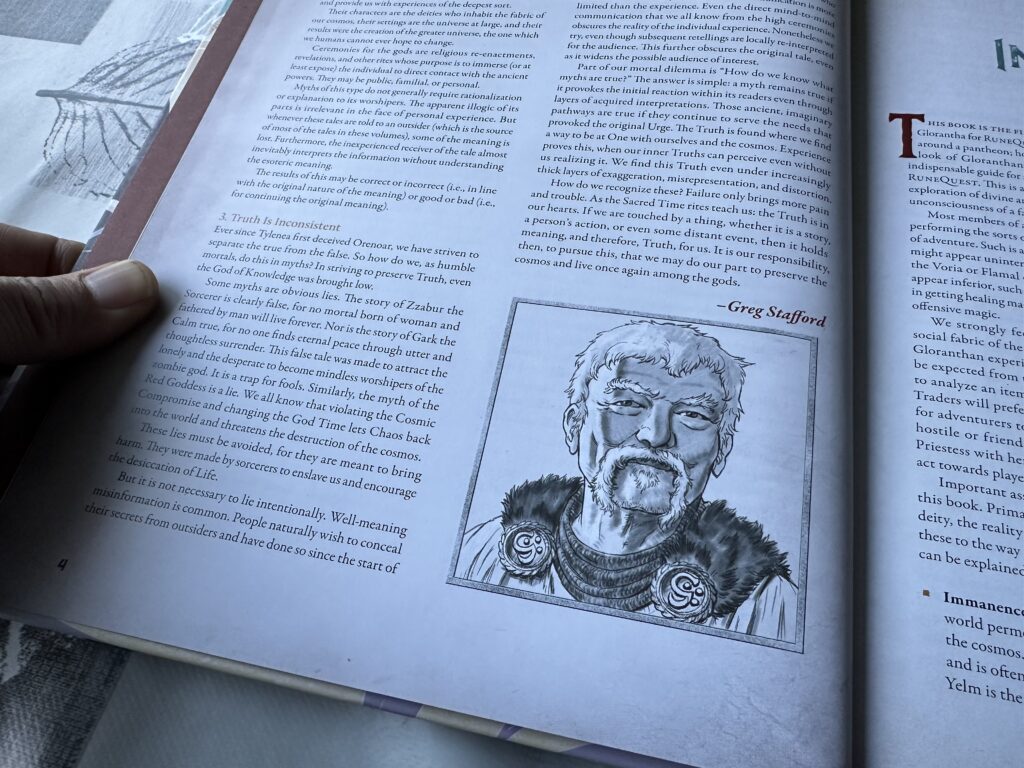
I suppose that this foreword accomplishes exactly what the author intended to do. It’s in turn insightful, confusing, revelatory, evident, and didactic. Different people will have as many different opinions of this.
But me? Well, first, I would not have titled this a “foreword”. That’s not what forewords usually are. And, as a somewhat cynical and nonspiritual Frenchman, I think that it takes a rather unproductive approach to addressing the couple of important points the reader needs to know: the participatory aspects of myths, their role in our understanding of the universe and our place in it, their idiomatic internal logic (or lack thereof), and the meanings we derive from them… this could have been presented more succinctly but hey, I’m no trickster-shaman.
Introduction
The Introduction does a good job of, well, introducing how Gloranthan mythology works to the reader. It also addresses a few related general topics, and in doing so we see two problems I have with this Mythology volume.
The first problem is that there is quite a bit of overlap with the Glorantha Sourcebook and the Guide to Glorantha, both of which also overlapped each other enough that David Scott had to create a page on the Well of Daliath to answer the common question of “which one should I buy?” For instance, the explanation of where “time” comes from, and how it works in Glorantha, is an edited version of what you can see in the Sourcebook (although I found the version in Mythology better). The detailed list of all the main Runes, or the later section on the nature of magic, are also found in the Sourcebook and the Guide.
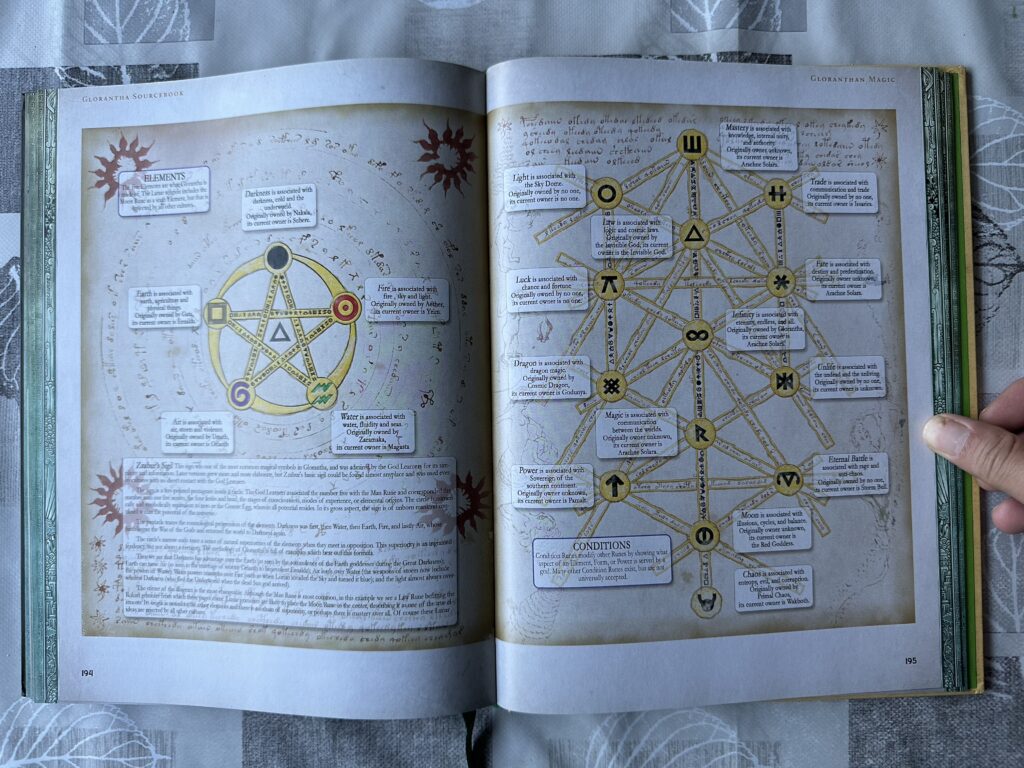
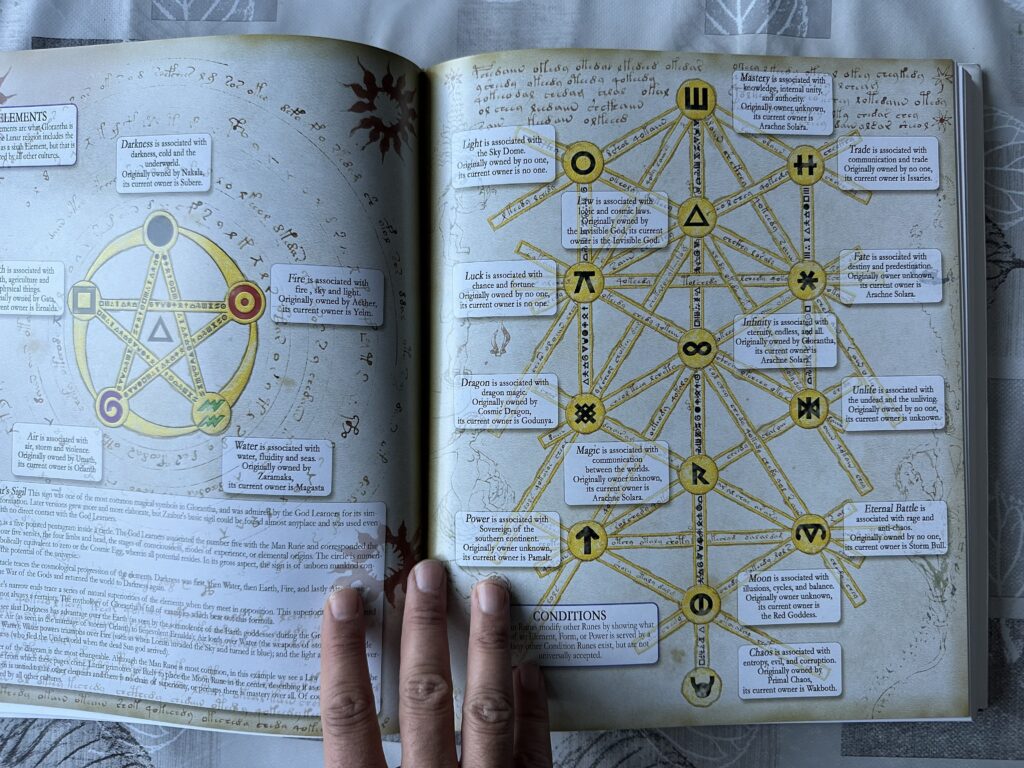

Of course, the Guide to Glorantha is a gigantic and expensive encyclopedia of pure lore that I’m not advocating at all should be a required purchase for RuneQuest readers. Similarly, the Glorantha Sourcebook is a systemless book that predates the current RuneQuest line. But it has been announced that the Sourcebook is getting a RuneQuest-branded reprint, so I predict that the confusion between the new Sourcebook and the Mythology book will force Chaosium to answer many more questions, and David Scott will have to make another comparative table to clear it up.
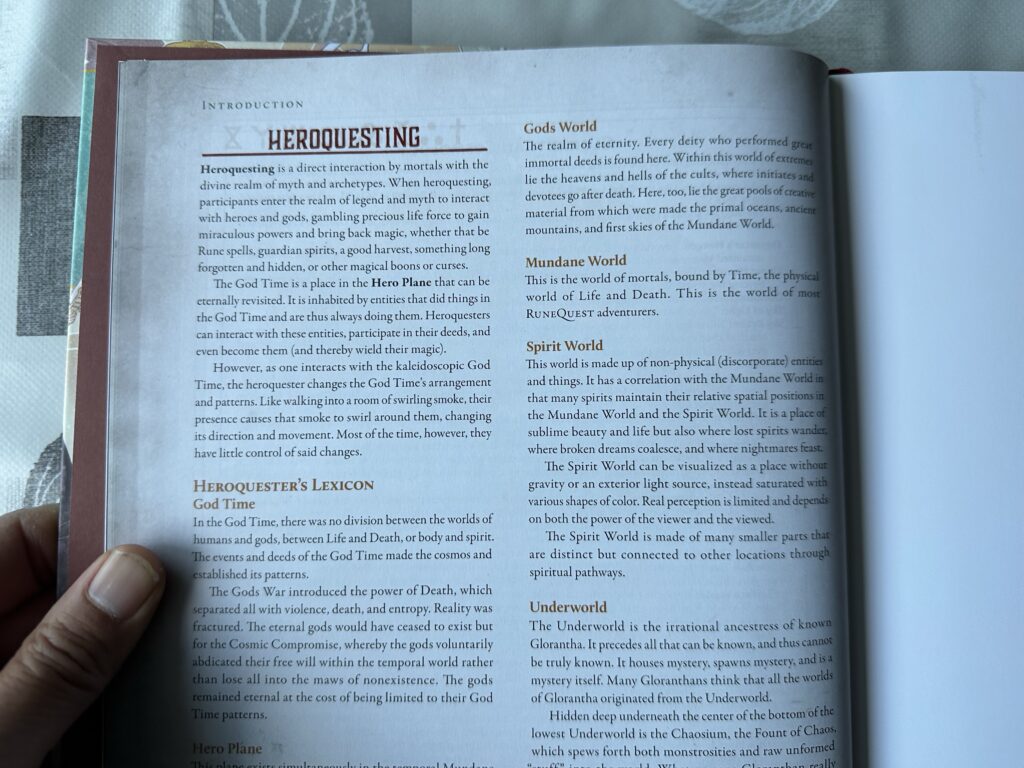
The other problem is the large section on heroquesting. On the one hand, it clarifies a few things about this elusive activity that’s only really been teased to new RuneQuest players for the past 6 years, and… well, let’s not talk about how long players of past editions have been waiting. But on the other hand, it still doesn’t tell us how to heroquest in RuneQuest.
When you consider that a large portion of this Mythology book, the Mythic Maps chapter, provides material for exploring the God Time, you have to wonder why on the lozenge are the authors continuing to tease us like this. In fact, it’s quite disappointing that a book that so strongly promotes a participatory approach to mythology (see page 76) does not include a short version of the ever-upcoming heroquesting rules in order for us to, you know, do what it asks of us. And if you’re about to argue that there wasn’t any room left for these rules, I would counter-argue that removing the overlap with the Sourcebook, and parts of the next two chapters (more on that soon) would free up plenty enough pages.
The World
This next chapter tries to present the geography of Glorantha. This is the part that I liked the least out of the whole book.
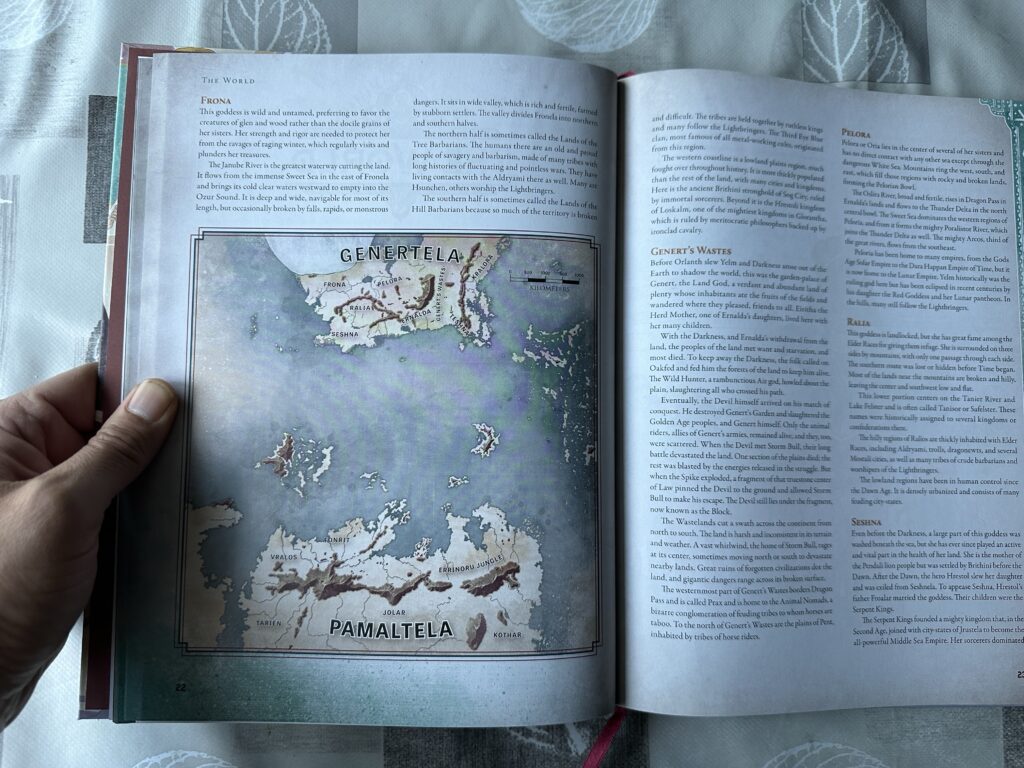
First, it approaches the geography of Glorantha through its land goddesses, which is something I don’t care much for, and which confused me when I first read it in the Glorantha Sourcebook. I understand that it gives a mythological twist, but it doesn’t work for me.
Second, it describes geography with only one very high level map of Glorantha (see above). References to Saird, the Rockwood Mountains, the Janube River, the Ozur Sound, Sog City, and many many others will invariably go over many readers’ heads. I’m of the possibly overly strict school of thought that unless you’re engaging in the sort of “vague and evocative literary world-building” common in the Sword & Sorcery genre, you shouldn’t talk about some place that you don’t have a map for. Maybe that’s what the authors intended to do here but, again, it doesn’t work for me.
Third, why do we even need a geographical presentation of Glorantha in an introduction to a series of cult splatbooks? Does it help choose and play an initiate of a cult in any way? I frankly can’t see how.
The Monomyth
Thankfully, we quickly go into God Learners territory: about 27 glorious pages of Monomyth goodness, outlining the entire “pre-history” of Glorantha.
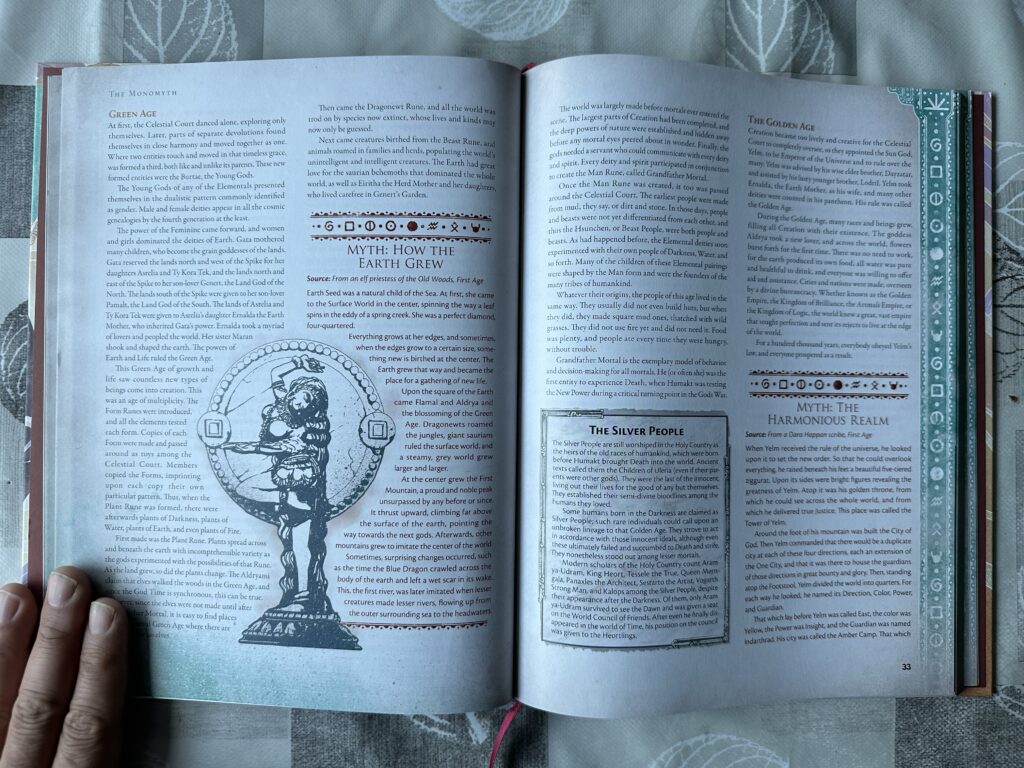
This is the usual retelling of the God Time story (again, overlapping with similar tales from the Sourcebook and the Guide), but interspersed with short myths, written “in character”. I love those! They provide a lot of Gloranthan flavour to a long text that, in its previous incarnations, could quickly become dry, but without going to the archaeological fac-simile extremes of King of Sartar. This strikes a nice balance that keeps me engaged throughout this tale of birth, growth, deicide, and reconciliation.
Speaking of overlap, we get a new version of the “Ten Copper Plates of Yuthuppa”, previously seen in the Guide to Glorantha. The new ones are very nice looking.
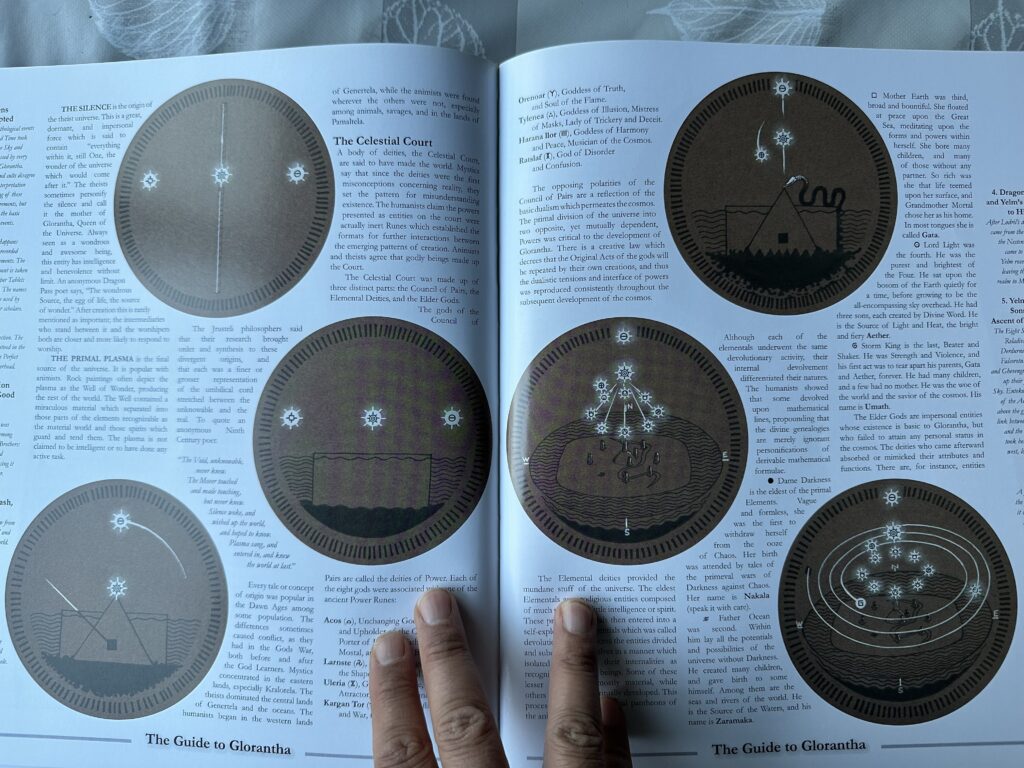
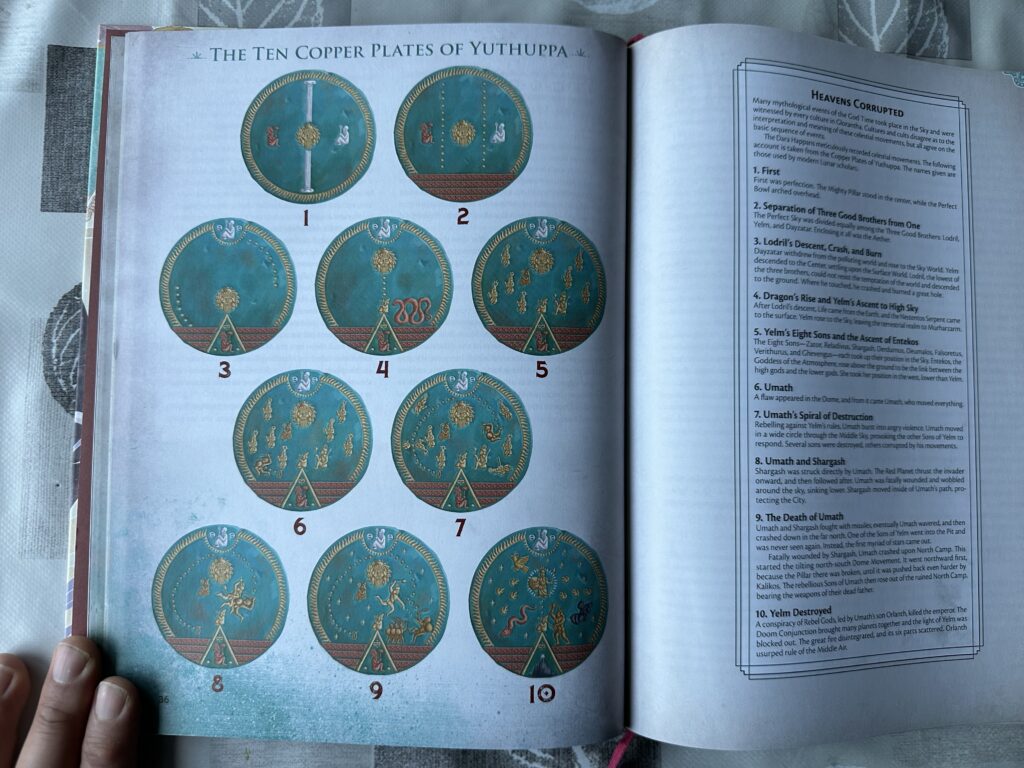
By comparison, the following 20-ish pages of Gloranthan post-Dawn history was a lot less entertaining without these “in-world artifacts”. I suppose that it’s still interesting, if you’re the kind of person who likes reading 20 pages of setting history (and I’m going to go out on a limb and say that if you’re a Glorantha fan, you at least probably don’t mind it), but I find some issues with this.
First, we’re out of the realms of mythology, which is what the book is supposed to be about. I understand that history and mythology are intertwined, especially in Glorantha where heroquesters can discover new myths and manipulate them, but what is the point of spending a tenth of the book on this? It may provide a bit of “historical basis” for players who want to understand why their cult is this or that way, but that’s what the Sourcebook and the Guide are for: they’re for people who want to deepen their understanding of Glorantha.
Second, it’s not really gameable material. The RuneQuest Starter Set had the good taste of boiling these 20 pages down to a couple pages because, well, who cares about what happened a thousand years ago with Argat or whatever his name was? (I had to try really hard to make our discussions relevant to modern RuneQuest players in our two episodes on the guy) So again, why is this here, especially when it’s already in the Sourcebook and the Guide?
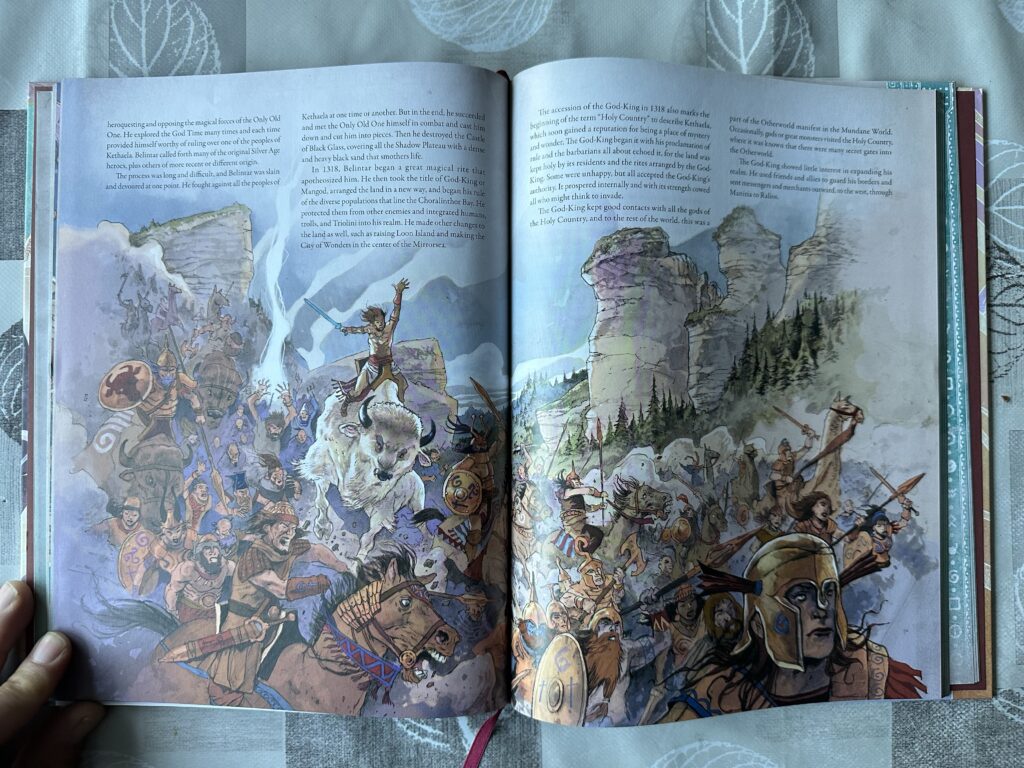

My gripes about non-gameable material go even deeper: this history of Glorantha presents many really really cool things that you “can’t” play with RuneQuest. Be honest and look at the two above pictures. Which one looks more awesome? Being a grunt in the muddy pitched battles of Argrath’s metaplot? Or being an EWF soldier riding with motherfucking dragons across Genertela? (repeat after me: “maybe Mongoose Publishing had the right idea”)
Sure, you can make Argrath’s Sartar Magical Union pretty draconically awesome too, assuming you have the Sourcebook to even know about it (there it is again), and assuming you do the work to play with that in your campaign. With some similar work you can participate in the Tournament of the Masters of Luck and Death (which doesn’t exist anymore) or the Lunar New Year Ceremony (which happens outside of Dragon Pass), or whatever else looks cool and interesting here.
But, again, why is all this in a Mythology book meant to be the introduction to a series of cult splatbooks?
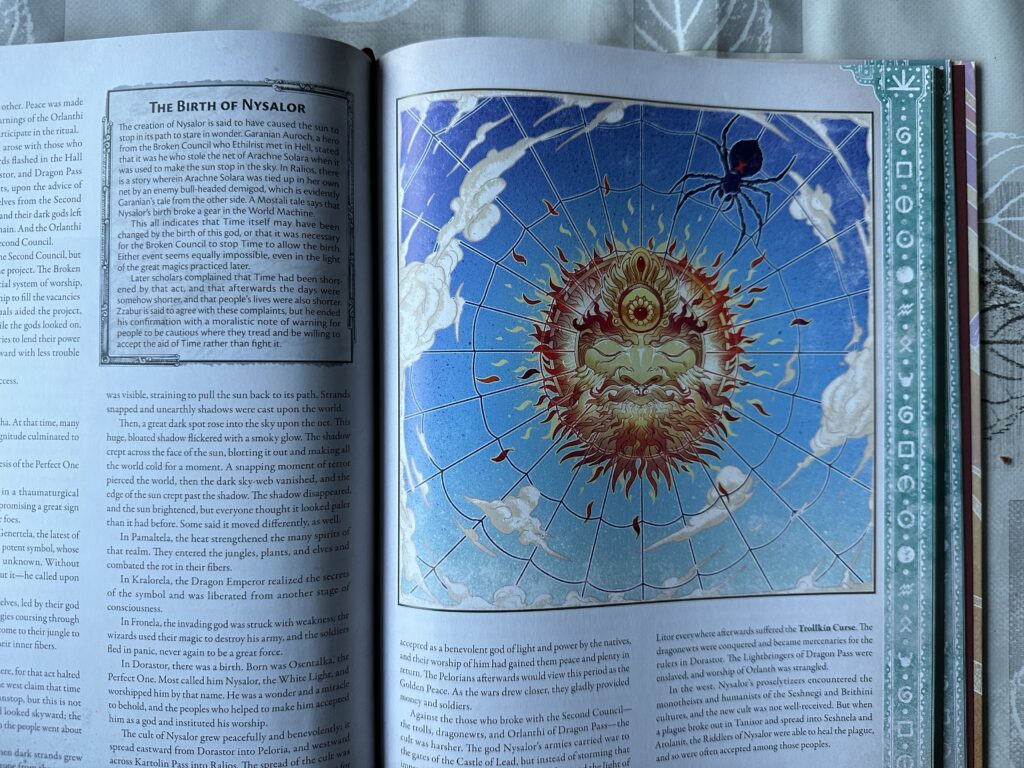
On the plus side, I haven’t done a full comparative study between the Mythology book’s version of Gloranthan history and the Sourcebook‘s or the Guide‘s (this reminds me, I should really check back on Joerg), but I got the impression that this version is much better. It is infused with more epic details and secondary characters. It presents the history of Glorantha with better grounding of events in societal and religious changes. People and cultures learn from each other, discover new things about their gods and their magic, and it all flows more convincingly. I’m pretty sure that this is all thanks to Jeff Richard’s ever-expanding knowledge of real-world ancient history, and its application to Glorantha.
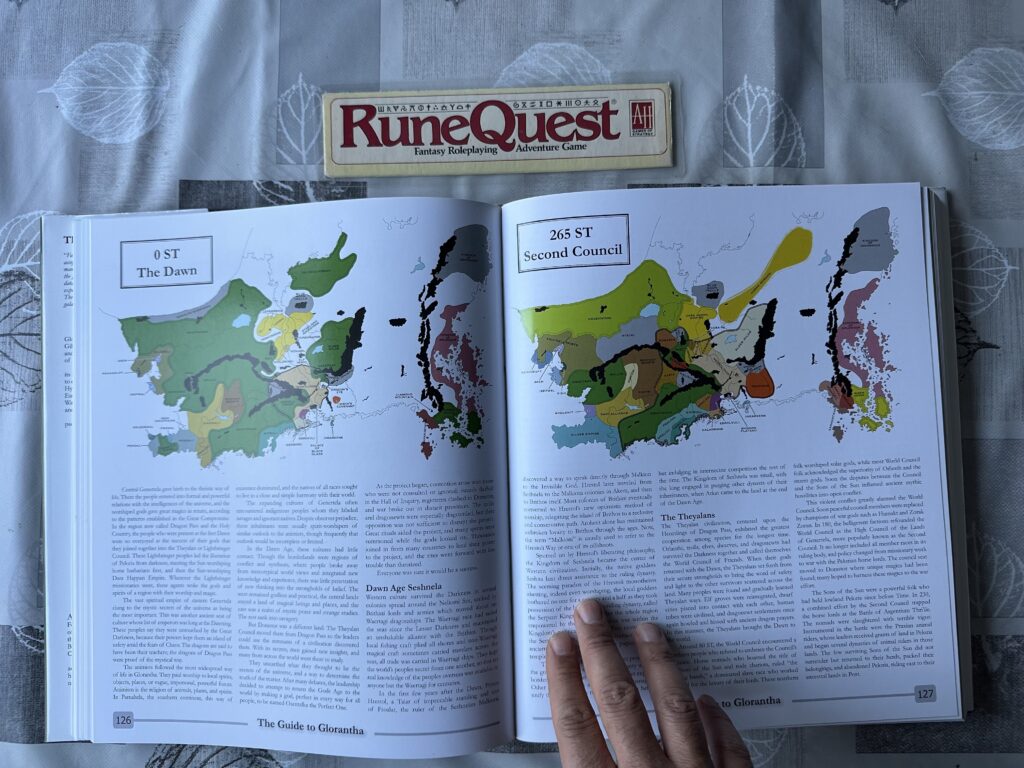
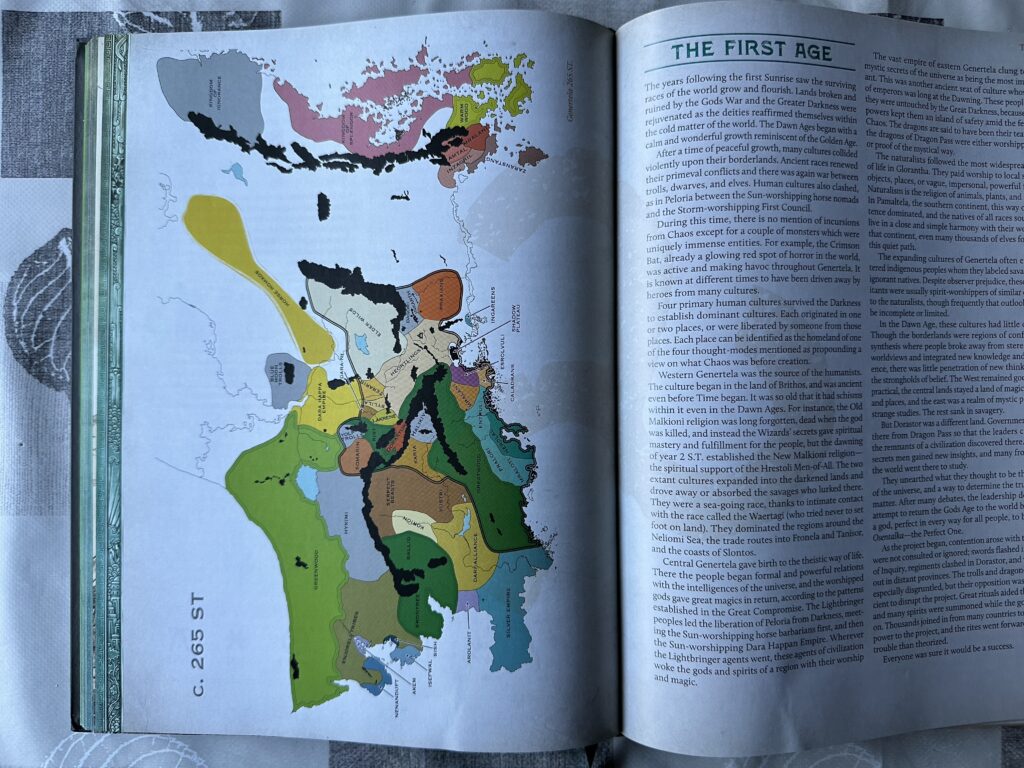
Note however that the Guide and the Sourcebook have very nice maps that can significantly help figuring out who’s who and what’s happening where across Gloranthan history (see the two photos above). If I didn’t already have some basic knowledge to rely on, I might have gotten confused and frustrated by the Mythology book’s purely textual history lesson. In my opinion, that’s another reason to cut the post-Dawn history and leave room for other things like heroquesting rules.
Understanding Mythology
This next chapter is one of the main pillars of this Mythology book: it tries to educate the reader about how mythology works in general, and in particular in Glorantha.
It starts by explaining that mythology is at its best when you witness it or participate in it, as opposed to simply reading it. Gloranthan scholars will recognize that this text, along with many other bits of texts in this book, comes from Stafford Library notes. But also, Chaosium keeps turning its knife in the heroquesting-rules-shaped wound that plagues our hearts.
The next few pages were entirely useless to me. I frankly have no idea what they were trying to say. I’m going to assume I’m just not smart or spiritual enough to understand, and move on.

We get to page 80, “The Sky Gods”, and it is absolutely great. It analyses the Sky pantheon, clearly explaining why its gods are the way they are, what archetypes they represent, how these archetypes interact with each other, and so on. In one absolutely brilliant page you get this pantheon and, as a result, its cults and cultists. This is not gameable material per se but it’s very actionable material. Thanks to this, gamemasters and players should be a lot more comfortable improvising new gods and spirits of the Sky pantheon.
I was very disappointed to see that the other pantheons were not broken down in the same way on the following pages. The analysis of the Sky gods was merely illustrative, and the reader is supposed to do go through the same exercise with the other pantheons on their own. Frankly, I would gladly trade the 4 previous pages to get the rest of this treatment.
The last few pages do highlight a couple of interesting points about Gloranthan mythology, but it sadly tries to illustrate these points with mentions that a new RuneQuest player would not have seen published before (the Dragonewts Dream, the Syndic’s Ban, etc.)
Mythic Maps
A large chunk of the Mythology book provides “mythic maps” of Glorantha. These are about 30 pages of maps and gazetteers of the God Time, illustrating the events that unfolded before the Dawn. These events were previously told in the Monomyth chapter, so you might flip back and forth a lot between the two chapters.
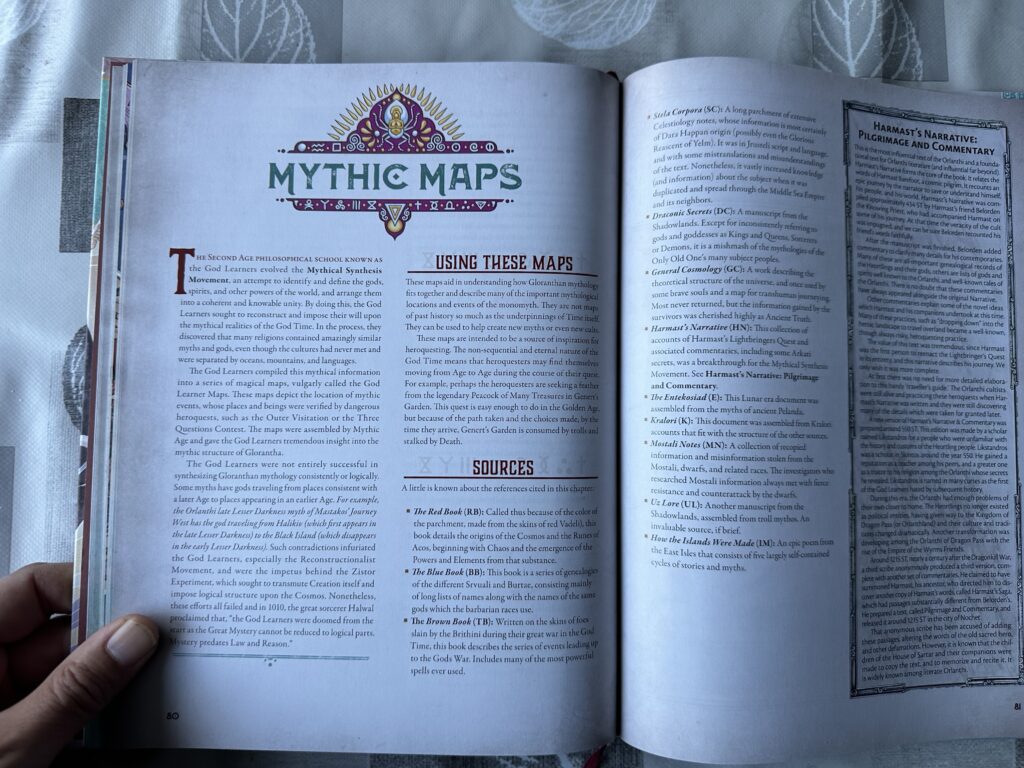
As with the Monomyth and its in-world texts, the mythic maps rely on a number of in-world “sources”. These include a mix of sorcerers’ tomes, ancient Sun-worshippers’ parchments, draconic documents, eastern mystics’ archives, and more. I really like this diegetic faux-archeology approach to RPG books. However, I’m not going to look too closely at which source says what compared to what other source, and try to reconstruct a deeper Gloranthan narrative from that… I’ll leave that to others. (Speaking of, has anybody seen Joerg? He’s not answering on Discord.)
Anyway, this is good stuff for a few reasons. First, you can name-drop these “well known” sources in a game to add some nice setting flavour to whatever an NPC says. When adventurers ask about the first river, formed when the Blue Dragon invaded the Earth, they don’t just get a little story about what happened and how Orlanth tamed it. Anantip the scribe can also tell them that we know this from Harmast’s Narrative, and that they might learn more from the complete copies found in the Jonstown Library before they embark on their heroquest, or whatever the adventure is about.
Second, it establishes all this knowledge through the lens of, effectively, an unreliable narrator. This information might be wrong or incomplete, which lets gamemasters change or add things as needed without that annoying player objecting that “it’s not supposed to be like that”.
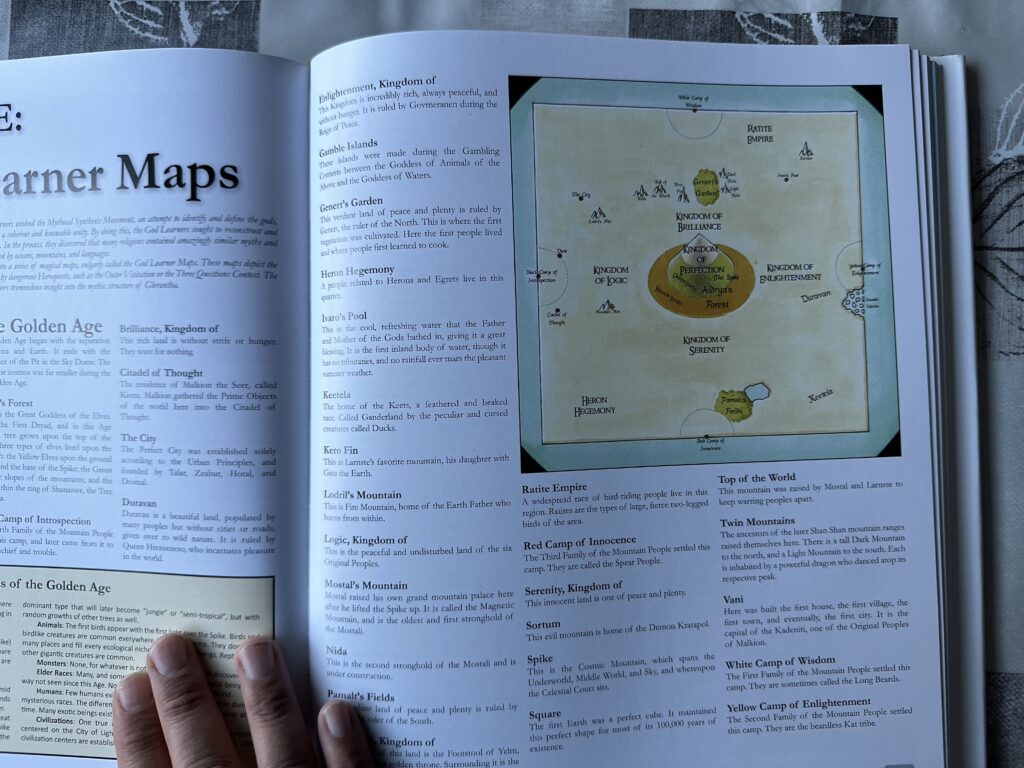
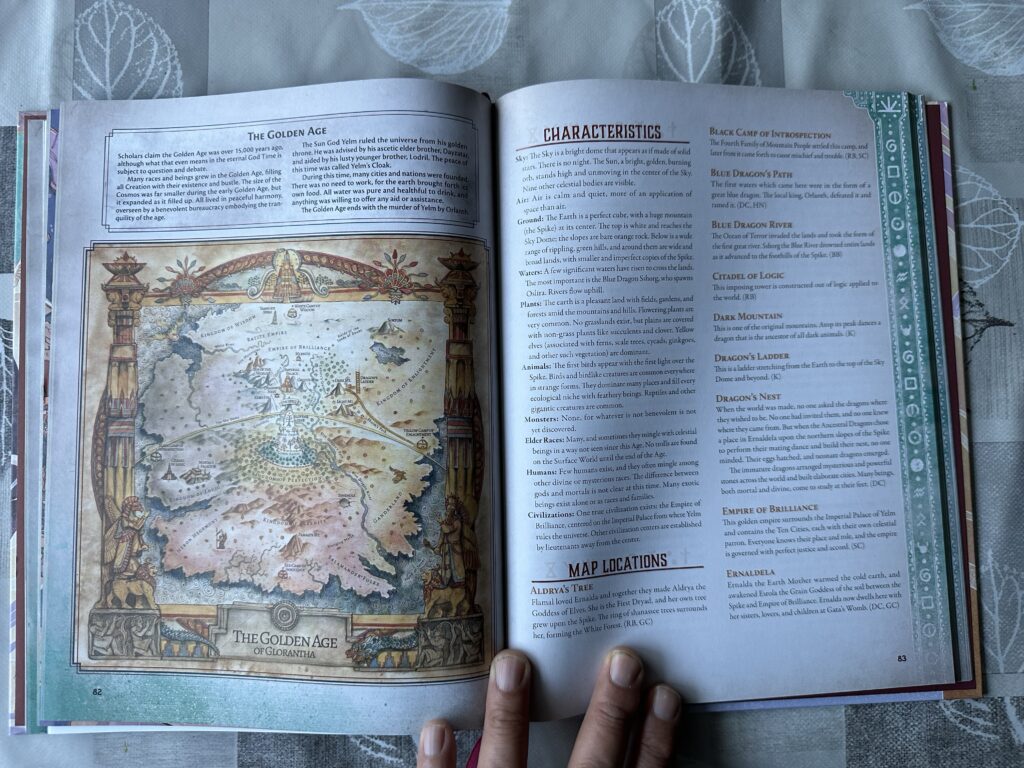
Content-wise, this is another large overlap with the Guide to Glorantha. Each map shows Glorantha at various “stages” of the monomyth, from the idyllic golden age, to the turbulent storm age of the rebel gods, to the lesser darkness that followed the murder of the sun god, to the invasion of the world by Chaos, and so on.
Each age’s characteristics are described (what plants and animals “exist”, what the sky looks like, etc), and a list of notable locations follows, each with a short description. The former seems pretty identical between the Guide and the Mythology book, while the latter has been heavily edited and expanded. But, unless my eyes are getting a bit too old, several locations named in the gazetteer are not labelled on the corresponding map. This makes me a bit sad.
At first glance, I prefer the Mythology book’s text, but I like the Guide‘s maps better. The new maps are harder to read, and the Guide‘s maps tell, in my opinion, a better “cartographic story”.
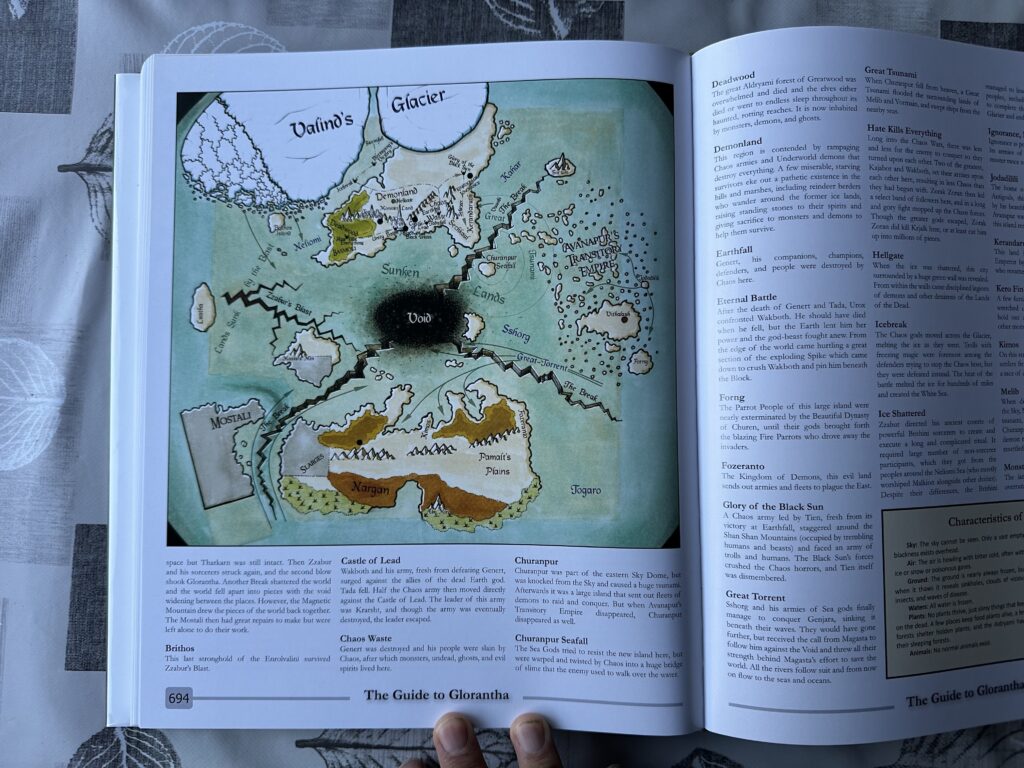
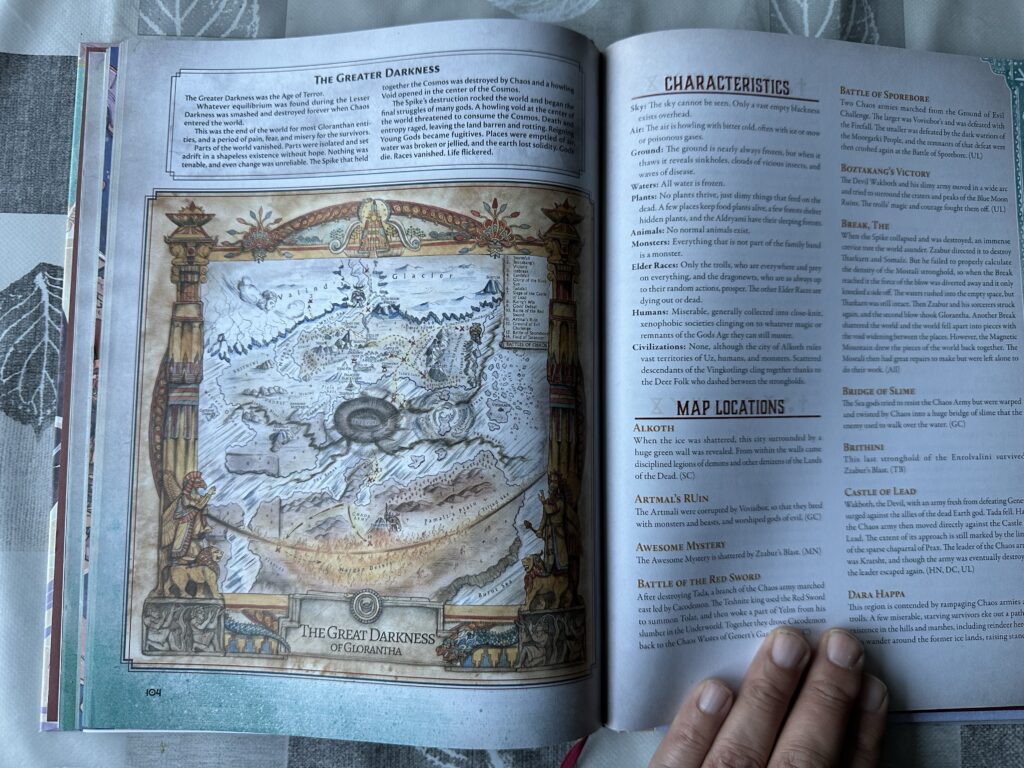
In this case I don’t mind the overlap between the Guide and the Mythology book. First because the Guide, given its size and price, is a very hard proposition for anybody who isn’t a hard-core Glorantha fan. Second, because these mythic maps belong in a RuneQuest book as useful gameable material for heroquests… or at least they would be if Chaosium had included the heroquesting rules here! If anything, I’m once again annoyed that the Mythology book tells us to include this in our games, but doesn’t give us the means to do so.
Until we actually get those heroquesting rules, it’s hard to say how useful these mythic maps are. There are no stats here, obviously, since we don’t have the rules. But even if the rules eventually get published, this is the equivalent of a wilderness sandbox setting where it simply read “a family of mighty trolls live here”. The gamemaster still has to figure out how powerful these trolls are and make some stats for them. Will we get a “heroquesting companion” that attaches stats and numbers to these mythic maps? Will Chaosium have to re-publish them (or something similar) from a more gamist and mechanical point of view? If the former, is that going to be practical to run? If the latter, why even publish these mythic maps here in the first place?
This is very perplexing, but I’m going to assume Chaosium has a plan, and just enjoy these maps. They’re maps! I like maps! And the gazetteers have lots of weird things going on! Why is nobody (except Sandy Petersen) talking about Kylerela, having adventures on a weird floating island? Why haven’t I setup a Cecil B. DeMille-esque catastrophe heroquest aboard Anaxial’s Boat? Is there any better place to play than the Terrifying Black Cloud? Are there better villains than the God Time Vadeli? This is fun!
Catalogue of the Gods
The next section is the “Catalogue of the Gods”, a presentation of Glorantha’s hundred-or-so most notable deities.
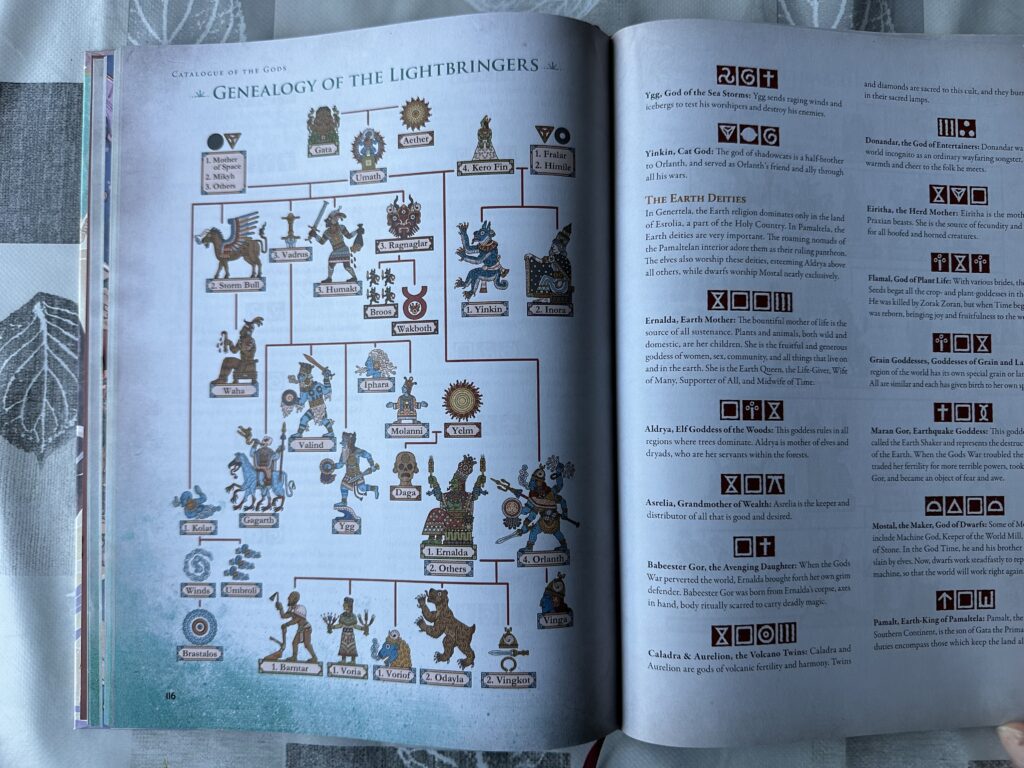
In many ways, this chapter acts like a table of contents for what you’ll find in the other Cults of RuneQuest books. Each pantheon is described in a format similar to that of the Prosopaedia (but with much shorter entries), and gets a full page genealogy diagram. I really, really love Katrin Dirim’s meso-american style for those.
Universal Cult Format
The next section brings a slightly weird tonal shift to the Mythology book. Until now we were in system-less mythological fantasy land, and all of a sudden we are reminded that this is a RuneQuest book after all.
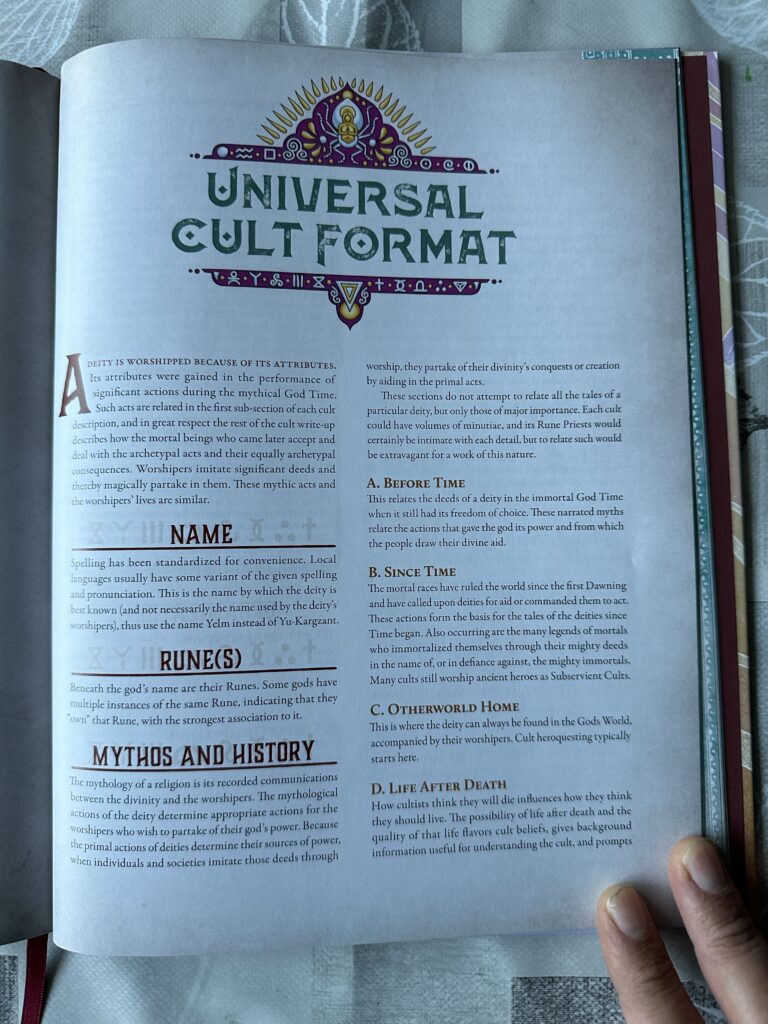
The “Universal Cult Format” establishes the ground rules for how cults are presented in the rest of the Cults of RuneQuest series. Those of you who were around in 1979 to read Cults of Prax will recognize here an expanded version of its own “Sample Cult”. It worked well then, since that section was part of the introduction. It works less well now, since people effectively have to buy this book to understand any other cult book, and now you have to check two books… but I guess there was no good alternative. Still, I’d like to see Chaosium release this chapter as a free PDF so that players who just buy one or two pantheon books don’t feel cheated.
Apart from general information about the cult write-up format, we get slightly more material and mechanics for lay, initiate, and Rune-level members of a cult. It paints a clearer picture of how a Gloranthan cult functions: worship, temple administration, finances, and more.
Funnily enough, I noted in my review of the Lightbringers book that some of the information seemed incomplete, such as the fact that Rune Priests are limited to DEXx5 for their Manipulation skills. It turns out that this was an editing mistake in the Lightbringers book, because the Mythology book did not carry that limitation over from Cults of Prax. So good news, priests: you now have enough free time to do karate!
This chapter isn’t just common cult information and basic mechanics.
On the one hand, we get some baffling repetition from the RuneQuest rulebook, of all things. Temple sizes, skill training costs, common Rune spells, and common Spirit Magic spells are all taking up valuable space without much notable differences.
On the other hand, we get wonderful nuggets such as “How Cults Change” and “What Happens on a Holy Day”. The first one explains how the God Time is fixed and eternal, but our knowledge and understanding of it evolves over time, bringing religious, political, and/or societal changes to cultists and their community. It a great little piece that might have been better located in the “Understanding Mythology” chapter. The latter gives you a lot of material to bring some narrative detail to cult holy days, and even maybe run an adventure or two during them.
Cult Distribution
The very last chapter speaks to nerds like me. That is: the type of nerd that makes spreadsheets. Spreadsheets are cool! Almost as cool as maps! So you know what’s doubly cool? Spreadsheets that give information about places on a map!
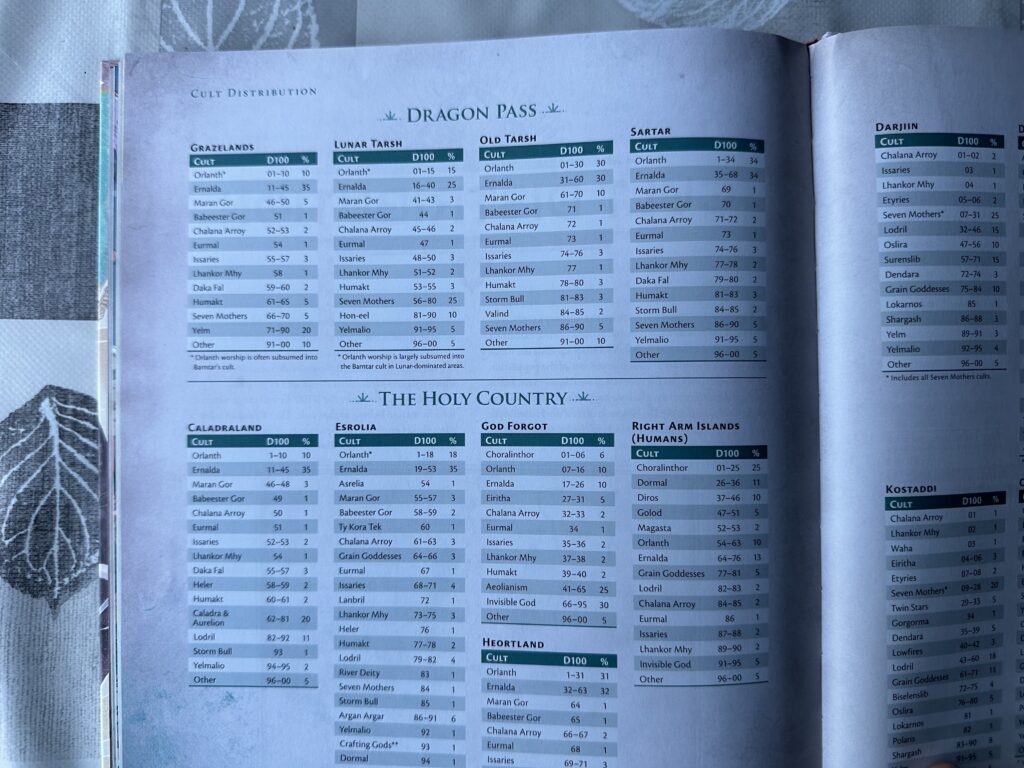
That’s what this chapter gives you: the percentage of population initiated into each cult, per geographical region across Peloria, Dragon Pass, Prax, the Holy Country, and Maniria. If you’ve seen the cult distribution numbers of Cults of Prax or Trollpak, imagine that but for a third of Genertela in one place.
This is great for world-building. Again, read my article on the usefulness of spreadsheets. And even if you don’t make spreadsheets, you can just roll a D100 on these tables whenever your players meet an NPC for which you don’t really have a cult in mind.
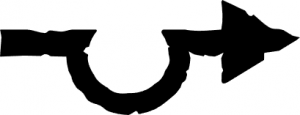
The Mythology book is a strange, fascinating, confusing beast, just like the topic it takes its name from. It mixes in- and out-of-character looks at Glorantha, setting lore and literary analysis, system-less material and RuneQuest mechanics, all in one beautiful book. It is unlike the vast majority of RPG sourcebooks in existence. It takes it reader seriously, and aspires itself to be taken as a serious piece of literature.
Given this variety of topics, the Mythology book is, well, a mixed bag by definition. I find it uneven and lacking cohesion. It reaches great heights as often as it makes me want to skip pages. Most importantly, the Mythology book compels the reader to explore Glorantha’s mythology for themselves, setting up heroquesting as the best way to do that, but fails to deliver the, ahem, mythic ruleset required to do this. People who buy this book to actually play in Glorantha might come out with more questions than answers. “What do I do with First Age history?” “What are these mythic maps for?” The book effectively throws a lot of great material at the reader, but it’s up to them to figure out what to do with it. Some might say that’s the mark of a great sandbox, but to me it’s a case of a book that can’t decide what its audience is.
On the other hand, the variety of the book means that you are almost guaranteed to find something interesting, useful, or even revelatory about gaming in Glorantha. Gloranthan scholars and hard-core fans might be ecstatic about the expanded monomyth and the new historical details. More casual RuneQuest players will greatly benefit from the high-level chapters and sidebars that help “grok” Glorantha. This is a book that clearly establishes how Glorantha a fantasy setting unlike any other: it’s deeper, more meaningful, and more awesome.
You can get Cults of RuneQuest: Mythology in PDF from DriveThruRPG (affiliate link), or in hardcover and/or PDF from Chaosium.



Hi – a nice review. I love the Mythology book but share some of your gripes. I continue to be frustrated by how Chaosium thinks it is acceptable to drop in mentions of places, people and events in their books without any explanation of them anywhere in the book – even for supposedly introductory books like this one and the sourcebook. And this book is supposed to be of interest to people with just a general interest in fictional mythologies! Of course the more I read on Glorantha the less this is an issue, until eventually I suppose I won’t even notice like the people writing and editing these books don’t notice – but it is a massive obstacle for people not steeped in the material. Also – I like your thought on playing in the second age! Playing within the EWF does sound like a lot of fun to me too. Would that make a good podcast episode – talking to people who runs games in second age Glorantha?
Indeed, I have internalized so many things in the few years I’ve played in Glorantha that I don’t even always realize when a book mentions something that newcomers would not know about… but every now and then I do double-check things and yeah, it’s real issue. To me it’s another editing problem plaguing the RQG line.
Playing in EWF would be interesting, yes, and you’re right that it might make a good podcast episode, or series of episodes… maybe we should take a look at the MRQ books… well, at least the ones written by Robin Laws and the other good writers. Mmmh. Thanks!